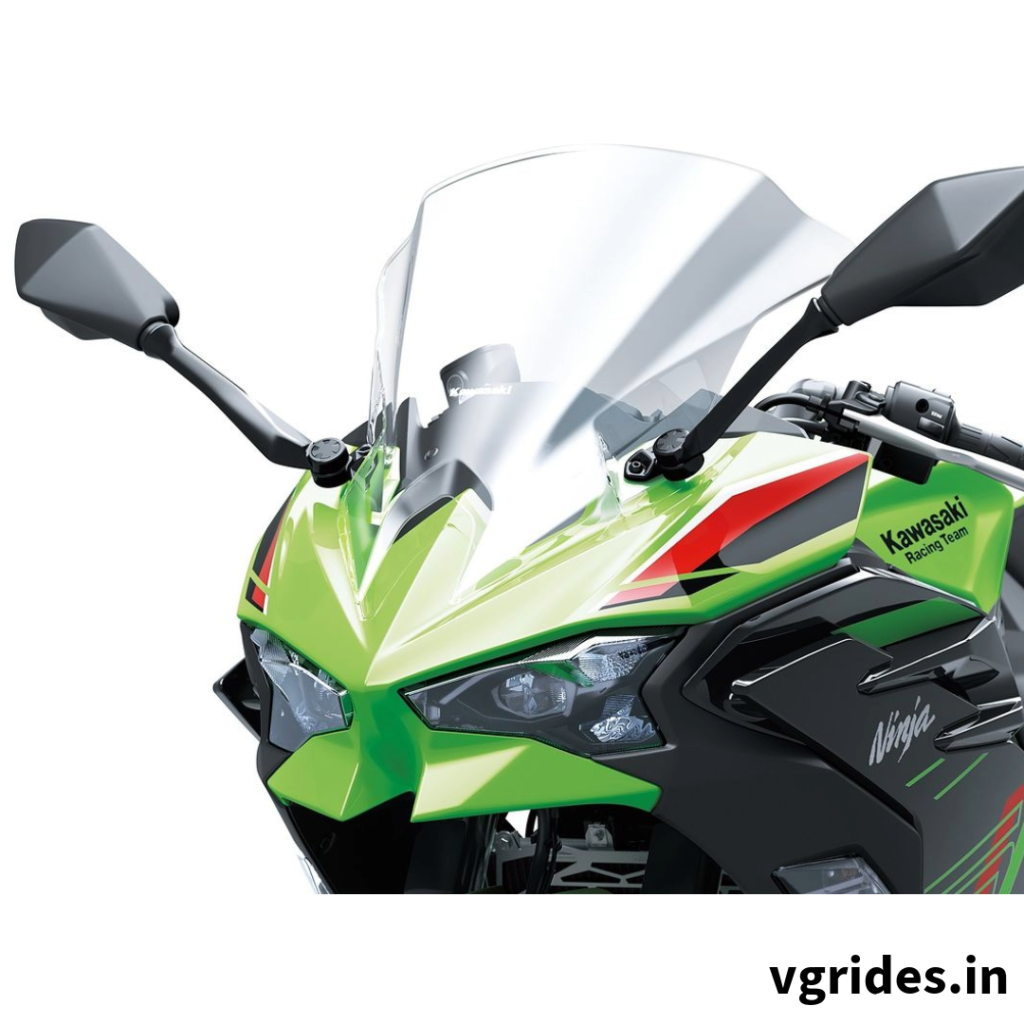Kawasaki Ninja 500’s specifications
| Category | Specification |
|---|---|
| Engine Type | Liquid-cooled, 4-stroke Parallel Twin |
| Displacement | 451 cm3 |
| Bore and Stroke | 70.0 x 58.6 mm |
| Compression Ratio | 11.3:1 |
| Valve System | DOHC, 8 valves |
| Fuel System | Fuel injection: ø32 mm x 2 |
| Ignition | Digital |
| Starting | Electric |
| Transmission | 6-speed, return |
| Maximum Power | 45 PS / 9,000 |
| Maximum Torque | 42.6 N·m / 6,000 |
| Frame Type | Trellis, high-tensile steel |
| Tire – Front | 110/70R17M/C 54H |
| Tire – Rear | 150/60R17M/C 66H |
| Wheelbase | 1,375 mm |
| Ground Clearance | 145 mm |
| Seat Height | 785 mm |
| Curb Mass | 171 kg |
| Fuel Capacity | 14 litres |
| Overall Dimensions (L x W x H) | 1,995 x 730 x 1,120 mm |
| Front Suspension / Wheel Travel | ø41 mm telescopic fork / 120 mm |
| Rear Suspension / Wheel Travel | Bottom-Link Uni-Trak, gas-charged shock / 130 mm |
| Front Brake | Semi-floating ø310 mm disc |
| Front Caliper | Balanced actuation dual-piston |
| Rear Brake | ø220 mm disc |
| Rear Caliper | Dual-piston |
Engine Specifications
The heart of the matter Kawasaki Ninja 500 is its powerful engine, with a refined liquid-cooled, 4-stroke Parallel Twin configuration. With a displacement of 451 cm3 and a bore and stroke measuring 70.0 x 58.6 mm, this engine delivers a compression ratio of 11.3:1. Equipped with a DOHC, 8-valve system, and fuel injection via 32 mm x 2 injectors, it ensures optimal performance in various riding conditions. The ignition is digital, providing precise control over engine timing, while the electric starter ensures hassle-free ignition. Additionally, the forced lubrication system with a wet sump design guarantees proper lubrication to all critical engine components. The transmission is a 6-speed, offering smooth gear transitions. The Kawasaki Ninja 500 generates a maximum power output of 45 PS at 9,000 and a maximum torque of 42.6 N·m at 6,000.
Electronic Rider Aid
The Kawasaki Ninja 500 may feature electronic rider aids such as traction control, ride modes, or ABS (Anti-lock Braking System) for enhanced safety and performance. These aids ensure stability and control, especially during challenging riding conditions.
Dimensions and Chassis

Constructed on a trellis, high-tensile steel frame, the Kawasaki Ninja 500 offers a stable and agile riding experience. With a rake/trail of 92 mm and equipped with ø41 mm telescopic fork front suspension and Bottom-Link Uni-Trak rear suspension with gas-charged shock and adjustable preload, it provides excellent handling and maneuverability. The bike rides on 110/70R17M/C 54H front and 150/60R17M/C 66H rear tires, ensuring optimal grip on various road surfaces. The fuel tank capacity is 14 liters, and the overall dimensions measure 1,995 x 730 x 1,120 mm.
Brakes and Suspension
The Kawasaki Ninja 500 is equipped with reliable braking and suspension systems to ensure precise control and safety. It features a semi-floating 310 mm disc front brake with balanced actuation dual-piston caliper, and a 220 mm disc rear brake with dual-piston caliper. The front suspension offers 120 mm of wheel travel, while the rear suspension provides 130 mm of wheel travel, allowing for a smooth and comfortable ride over varying terrain.
In conclusion, the Kawasaki Ninja 500 sets a new standard in the world of sports motorcycles with its powerful engine, advanced features, and agile handling. Whether cruising through city streets or carving through winding roads, this bike offers an exhilarating riding experience like no other.
FAQs
What is the engine type of the Kawasaki Ninja 500?
The Kawasaki Ninja 500 features a liquid-cooled, 4-stroke Parallel Twin engine.
What are the dimensions of the Kawasaki Ninja 500?
The overall dimensions of the Kawasaki Ninja 500 measure 1,995 x 730 x 1,120 mm (length x width x height).
What is the maximum power output of the Kawasaki Ninja 500?
The Kawasaki Ninja 500 generates a maximum power output of 45 PS at 9,000 and 42.6 Nm at 6000 rpm
What is the curb mass of the Kawasaki Ninja 500?
The curb mass of the Kawasaki Ninja 500 is 171 kg.
What is the fuel capacity of the Kawasaki Ninja 500?
The fuel tank capacity of the Kawasaki Ninja 500 is 14 liters.
Does the Kawasaki Ninja 500 come with adjustable suspension?
The Kawasaki Ninja 500 features an adjustable rear suspension with gas-charged shock and adjustable preload, offering some level of customization.



